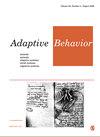生命系统的时间和情感结构:热力学视角
IF 1.3
4区 计算机科学
Q4 COMPUTER SCIENCE, ARTIFICIAL INTELLIGENCE
引用次数: 0
摘要
认知科学的主动行为方法以及当代神经科学的研究都认为,我们需要重新定义暂时性和情感在大脑中的作用。这些理论并不局限于特殊的能力,比如情绪状态和计时,它们认为时间和影响都构成了思想和认知的基本方面。如果这是真的,人们应该如何概念化这两个基本方面之间的关系?本文提供了一种从这一基本意义上理解时代性与情感性之间关系的方法。特别是,本文通过将自我维持的活动概念与生命系统组织的热力学信息观点相结合,为正在进行的结构临时性和情感性的讨论做出了贡献。在阐述时间性和情感性在维持热力学非平衡中的作用时,我将认为,时间性和情感性应被视为同一枚硬币的两面——也就是说,强调同一过程的两种不同方式。这一过程对应于生物和环境作为一个生命系统的功能两极的持续分化。因此,生命系统的时间和情感结构可以被看作是生命系统在热力学非平衡状态下维持自身的经纬。本文章由计算机程序翻译,如有差异,请以英文原文为准。
The temporal and affective structure of living systems: A thermodynamic perspective
Enactive approaches to cognitive science as well as contemporary accounts from neuroscience have argued that we need to reconceptualize the role of temporality and affectivity in minds. Far from being limited to special faculties, such as emotional mental states and timekeeping, these accounts argue that time and affect both constitute fundamental aspects of minds and cognition. If this is true, how should one conceptualize the relation between these two fundamental aspects? This paper offers a way to conceptualize and clarify the relation between temporality and affectivity when understood in this fundamental sense. In particular, the paper contributes to ongoing discussions of structural temporality and affectivity by combining enactive notions of self-maintenance with a thermodynamically informed view of the organization of living systems. In situating temporality and affectivity by way of their role for the maintenance of thermodynamic non-equilibrium, I will argue that temporality and affectivity should be regarded as two sides of the same coin—that is, two distinct ways of highlighting one and the same process. This process corresponds to the continued differentiation of organism and environment as functional poles of a living system. The temporal and affective structure of living systems may thus be seen as the warp and weft by which living systems maintain themselves in terms of thermodynamic non-equilibrium.
求助全文
通过发布文献求助,成功后即可免费获取论文全文。
去求助
来源期刊

Adaptive Behavior
工程技术-计算机:人工智能
CiteScore
4.30
自引率
18.80%
发文量
34
审稿时长
>12 weeks
期刊介绍:
_Adaptive Behavior_ publishes articles on adaptive behaviour in living organisms and autonomous artificial systems. The official journal of the _International Society of Adaptive Behavior_, _Adaptive Behavior_, addresses topics such as perception and motor control, embodied cognition, learning and evolution, neural mechanisms, artificial intelligence, behavioral sequences, motivation and emotion, characterization of environments, decision making, collective and social behavior, navigation, foraging, communication and signalling.
Print ISSN: 1059-7123
 求助内容:
求助内容: 应助结果提醒方式:
应助结果提醒方式:


